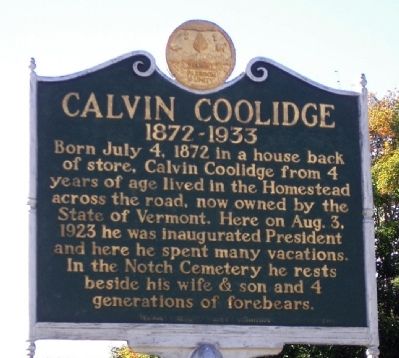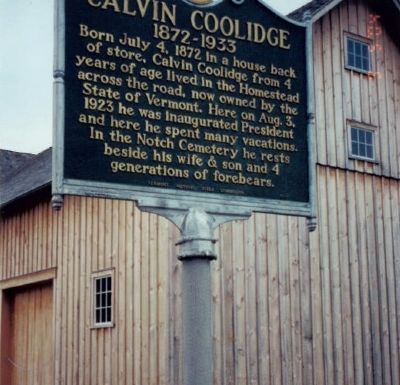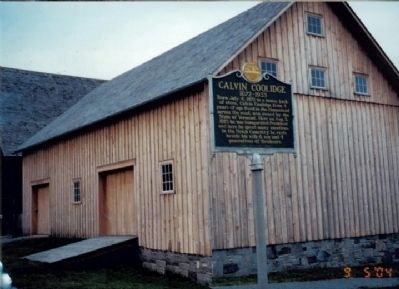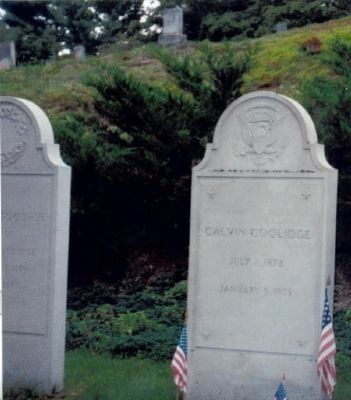Plymouth Notch in Windsor County, Vermont — The American Northeast (New England)
Calvin Coolidge
1872 - 1933
Erected by Vermont Historic Sites Commission.
Topics and series. This historical marker is listed in this topic list: Cemeteries & Burial Sites. In addition, it is included in the Former U.S. Presidents: #30 Calvin Coolidge series list. A significant historical month for this entry is July 1799.
Location. 43° 32.129′ N, 72° 43.295′ W. Marker is in Plymouth Notch, Vermont, in Windsor County. Marker is on Vermont Route 100A. Touch for map. Marker is at or near this postal address: 3780 Route 100A, Plymouth VT 05056, United States of America. Touch for directions.
Other nearby markers. At least 8 other markers are within 7 miles of this marker, measured as the crow flies. Plymouth WW1 Memorial (a few steps from this marker); Calvin Coolidge Homestead (within shouting distance of this marker); Capt. John Coolidge Flagpole (about 600 feet away, measured in a direct line); Achsa W. Sprague (1827-1862) (approx. ¼ mile away); Vermont Gold Rush (approx. 4.3 miles away); Revolutionary War Campground on the Crown Point Road (approx. 4.3 miles away); Bridgewater World War I Monument (approx. 6.1 miles away); Bridgewater Veterans Memorial (approx. 6.1 miles away).
Also see . . . Wikipedia - Calvin Coolidge. (Submitted on October 21, 2015, by Kevin Craft of Bedford, Quebec.)
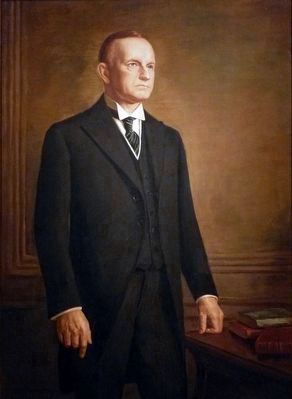
Photographed By Allen C. Browne, August 9, 2015
5. Calvin Coolidge
This 1956 portrait of Calvin Coolidge by Joseph E. Burgess (after Ercole Cartotto) hangs in the National Portrait Gallery in Washington, DC.
“Americans expect their presidents to be active, which explains why Calvin Coolidge has been labeled by historians as the ‘quiet president’ and an ‘American enigma.’ Coolidge was propelled to national prominence, and the vice presidency, by his decision, while governor of Massachusetts, to fire striking officers in Boston's police strike of 1919, proclaiming, ’there is no right to strike against the public safety by anybody, anywhere, any time.’ Assuming the presidency after Warren Harding's death in 1923, Coolidge determined not to do anything to upset American prosperity. Upon election to the presidency, Coolidge, in his 1925 inaugural address the first on radio expressed his belief that ‘the people of America [should] … work less for the government and more for themselves.… That is the chief meaning of freedom.’ When Coolidge left office, political commentator Walter Lippmann wrote, ‘Surely no one will write of those years … that an aggressive president altered the destiny of the Republic. Yet … no one will write … that the Republic wished its destiny to be altered.’” — National Portrait Gallery
“Americans expect their presidents to be active, which explains why Calvin Coolidge has been labeled by historians as the ‘quiet president’ and an ‘American enigma.’ Coolidge was propelled to national prominence, and the vice presidency, by his decision, while governor of Massachusetts, to fire striking officers in Boston's police strike of 1919, proclaiming, ’there is no right to strike against the public safety by anybody, anywhere, any time.’ Assuming the presidency after Warren Harding's death in 1923, Coolidge determined not to do anything to upset American prosperity. Upon election to the presidency, Coolidge, in his 1925 inaugural address the first on radio expressed his belief that ‘the people of America [should] … work less for the government and more for themselves.… That is the chief meaning of freedom.’ When Coolidge left office, political commentator Walter Lippmann wrote, ‘Surely no one will write of those years … that an aggressive president altered the destiny of the Republic. Yet … no one will write … that the Republic wished its destiny to be altered.’” — National Portrait Gallery
Credits. This page was last revised on December 24, 2019. It was originally submitted on June 7, 2009, by Chase Murphy of New York, New York. This page has been viewed 1,675 times since then and 22 times this year. Last updated on June 16, 2014, by Kevin Craft of Bedford, Quebec. Photos: 1. submitted on June 7, 2009, by Chase Murphy of New York, New York. 2, 3, 4. submitted on July 29, 2009, by Bill Coughlin of Woodland Park, New Jersey. 5. submitted on October 17, 2015, by Allen C. Browne of Silver Spring, Maryland. • Bill Pfingsten was the editor who published this page.
